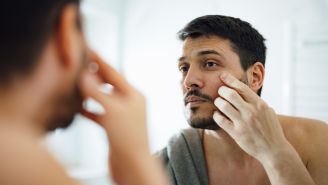4 ways to protect your skin after skin cancer
Here are four ways to protect your skin and reduce your risk of getting more skin cancer.
Updated on April 4, 2024

If you've had melanoma once, your odds of getting it again are nine times higher than for people who have not had this type of skin cancer, which is uncommon but grows and spreads quickly in the body. Even if you haven't had melanoma, but instead have had another kind of skin cancer, you have an increased risk of developing skin cancer again.
That's why it's so important to protect yourself. With some preparation and vigilance, you can take steps to help prevent this potentially deadly disease from coming back.

Use plenty of sunscreen
Regularly applying a good sunscreen is one of the best things you can do to protect against developing skin cancer a second time.
Choose a brand with broad-spectrum ultraviolet (UV, the type of light that causes damage to skin) protection and an skin protection factor (SPF, which measures how well a sunscreen protects against UV light) of at least 30; the higher the number, the better. Apply it before you leave the house, and then every one to two hours throughout the day, more often if you're sweating heavily or swimming. Don't forget your ears, nose, under your eyes, your hairline, the back of your neck, the tops of your feet, and your scalp if your hair is thin.
Remember not to save sunscreen exclusively for beach days; you're just as likely to get sunburned in a garden or park as you are at the beach. Apply it every day, in all types of weather.

Think beyond the lotion
While sunscreen is an important for protecting against harmful UV radiation from the sun, it's not your only defense. Other strategies include:
- Staying indoors between 10 a.m. and 4 p.m., when sunlight is most intense
- Staying in shady areas when you are outside
- Wearing clothes that protect against UV light rays, such as UV-protective sunglasses, a wide-brimmed hat, and light, long-sleeve clothing made of tightly woven fabric—cotton instead of linen, for example.
Also, skip tanning salons, which are thought to cause more than 400,000 skin cancers in the United States each year. If you prefer to look tanned, choose a self-tanner with built-in sunscreen instead.

Perform self-checks
When you have a history of skin cancer, it's a good idea to get acquainted with your skin and markings like moles or birth marks. Performing a monthly self-exam is a good way to do this. You'll learn your potential problem areas and how to identify changes over time, while understanding the "ABCDE" warning signs of abnormal moles:
- Asymmetry: Does one half of the mole look different in size or color than the other?
- Border: Is the edge of the mole rough, bumpy, blurry, or irregular?
- Color: Is the color different across the mole? Does it include patches of pink, white, red, blue, black, or brown?
- Diameter: Is the mole about the size of a pencil eraser or larger? (Keep in mind that sometimes melanomas can be smaller than this.)
- Evolving: Is the mole changing in size, shape, or color?
For hard-to-see spots on your back, neck, and top of your head—where skin cancer can be easily missed—ask a friend or family member to help you. Use your smartphone to record notes and take pictures of moles, too. It'll make it easier to detect changes from month to month. If you notice any changes, visit your healthcare provider (HCP) as soon as you can.

Attend follow-up care
Once you've been treated for skin cancer, you'll need to see an HCP regularly for monitoring in case the cancer grows back. The American Academy of Dermatology recommends visiting a board-certified dermatologist every year for a full-body exam. Depending on the type of cancer you had and other medical conditions, you may require more frequent checkups or additional tests. For many types of cancer, treatment often works better when it is identified earlier.
Your HCP may also recommend a change in lifestyle. While it's not proven to prevent skin cancer from returning, maintaining a healthy lifestyle—regular exerce as you are able, a healthy diet rich in fruits, vegetables, whole grains and lean protein, and low in salt, added sugars and saturated fat (which is solid at room temperature, like butter), managing stress, and quitting tobacco if you smoke—can help prevent chronic illness and help your treatment work better.

American Academy of Dermatology Association. “Skin Cancer Stats.” 2021. Accessed May 21, 2021.
Cancer Research UK. “Skin care after skin cancer.” October 22, 2019. Accessed May 21, 2021.
American Cancer Society. “Living as a Basal or Squamous Cell Skin Cancer Survivor.” July 26, 2019. Accessed May 21, 2021.
AH Fischer, TS Wang, et al. “Sunburn and sun-protective behaviors among adults with and without previous nonmelanoma skin cancer (NMSC): A population-based study.” Journal of the American Academy of Dermatology. August 1, 2016. Volume 75, Issue 2, pp 371-379.e5.
American Cancer Society. “How Do I Protect Myself from Ultraviolet (UV) Rays?.” July 23, 2019. Accessed May 21, 2021.
Skin Cancer Foundation. “Skin Cancer Prevention” 2021. Accessed May 21, 2021.
Cancer.net. “Skin Cancer (Non-Melanoma): Follow-Up Care.” July 2019. Accessed May 21, 2021.
E Benati, C Longo, et al. “Baldness and scalp melanoma.” Journal of the European Academy of Dermatology and Venereology. December 2017. 31(12):e528-e530.
American Academy of Dermatology Association. “Indoor tanning use.” 2021. Accessed September 15, 2021.
More On


video

article

slideshow


video


video
